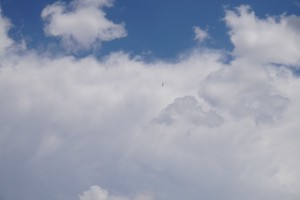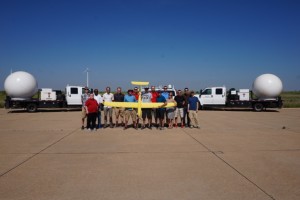Hi everyone, I’m writing a little earlier this week because tomorrow I’ll be traveling back to Boulder for the remainder of my internship.
This week, we wrapped up our deployment in Lubbock by testing the entire system. The radar trucks were able to provide wind data for the flight planners, which gave the aircraft trajectories to follow that would maximize the soaring potential of the wind as the plane flew towards a destination. This is intended to maximize the amount of time the aircraft can stay aloft by using thermals and gliding to reduce engine usage. We were able to get the Tempest to stay up over twice as long as we had previously, largely because of the flight planning systems that we were testing.

The Tempest in flight in front of the top of the thunderhead it was sampling.
The team was also able to obtain samples from a storm that passed over the airfield, proving that the UAS could efficiently obtain atmospheric data from a storm while under full automation. All that was needed to run the system by the end of the week was a few button presses here and there; the vast majority of the work from planning the trajectories to flying the Tempest was all done by computer. We have considered the deployment a full success and RECUV will be able to use the technology to safely and efficiently provide weather data from severe storms in the future.

The entire team, including researchers from RECUV and Texas Tech, holding the Tempest while standing in front of our control van and the two radar trucks.
Next week, I will get settled in Boulder and start working in the lab for the month of July. I’m looking forward to working with RECUV on their next project, which will begin testing just after I leave.

Hey kiddo, I’m enjoying your posts. I’ve always been fascinated with things that fly but never graduated past milkweed seeds and Frisbees lol! Your use of thermals to prolong flight and save engine wear is really cool. Great job, glad you are having fun.